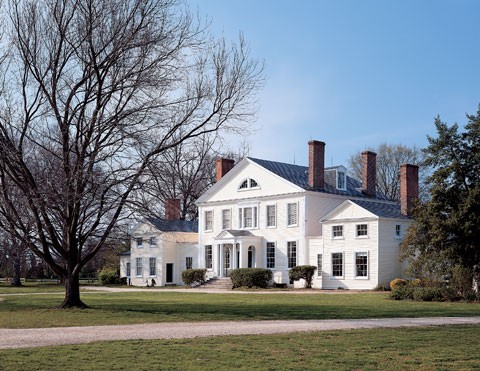
Wye House, Talbot County, Maryland, ca. 1787. (Photo, Gavin Ashworth.)
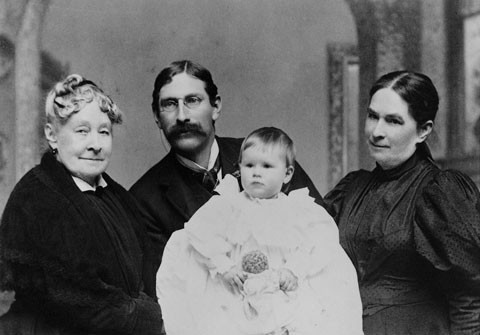
Circa 1896 photograph showing (left to right) Elizabeth Phoebe Key Howard, Charles Howard Lloyd, Joanna Leigh Lloyd, and Mary Lloyd Howard Lloyd.
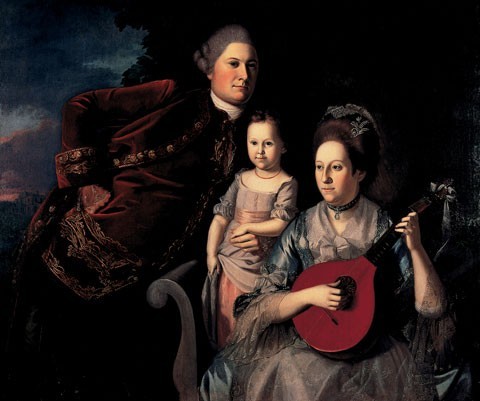
Charles Willson Peale, The Edward Lloyd Family, Maryland, 1771. Oil on canvas. 48" x 57 1/2". (Courtesy, Winterthur Museum.)
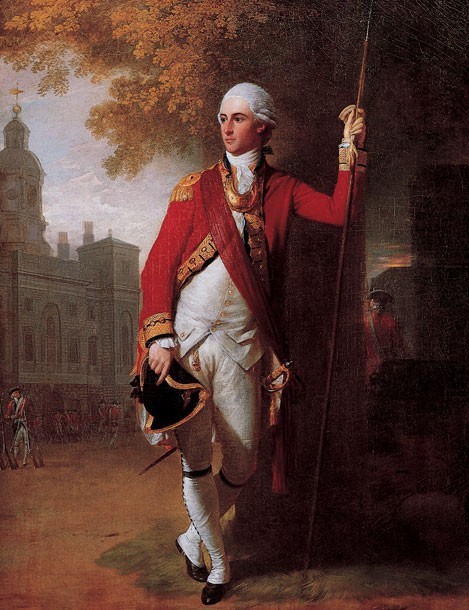
Benjamin West, Richard Bennett Lloyd, London, ca. 1773. Oil on canvas. 36" x 28". (Photo, Gavin Ashworth.)
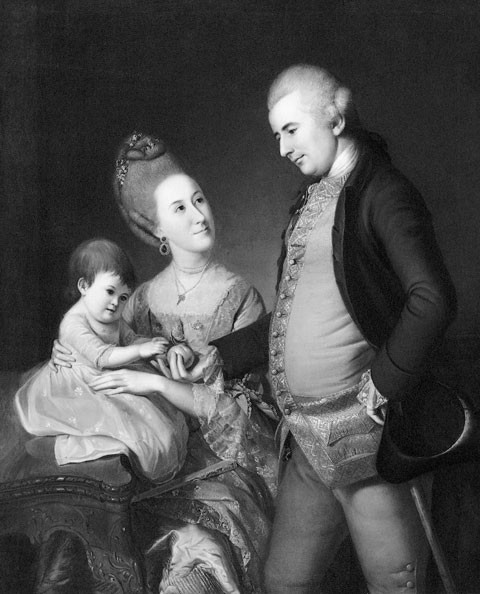
Charles Willson Peale, The Family of John Cadwalader, Philadelphia, 1771. Oil on canvas. 51 1/2" x 41 1/4". (Courtesy, Philadelphia Museum of Art.)
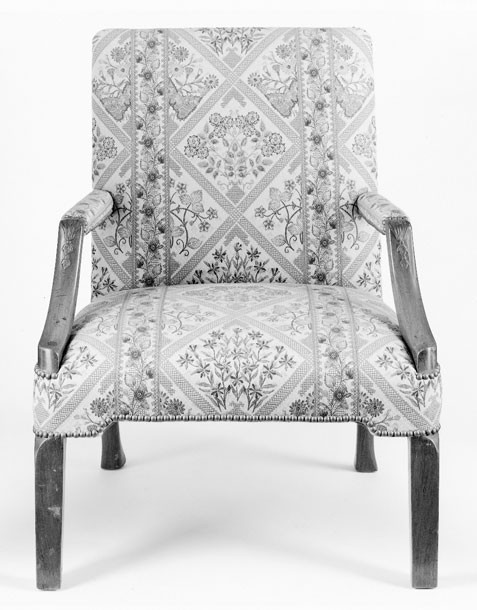
Upholstered armchair, England, ca. 1760. Walnut with beech. H. 37 3/4", W. 28 1/4", D. 23". (Photo, Gavin Ashworth.)

Tall clock case, probably Easton, Maryland, ca. 1790. Walnut with tulip poplar, yellow pine, and oak. H. 91", W. 19", D. 10". (Photo, Gavin Ashworth.) The movement is by Daniel Quare and Stephen Horseman of London and dates about 1715.
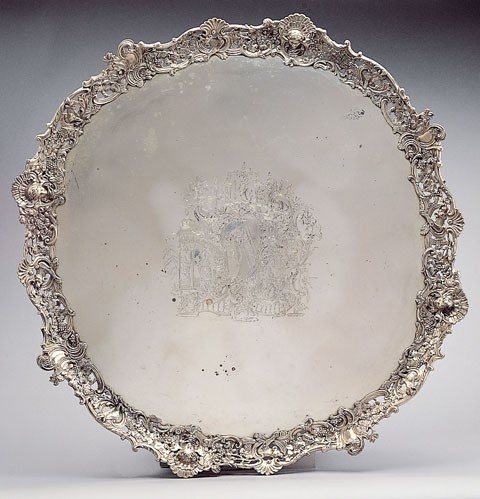
Salver by Jacob Marsh, London, 1754. Silver. H. 3 1/2", Diam. 28". (Photo, Gavin Ashworth.)
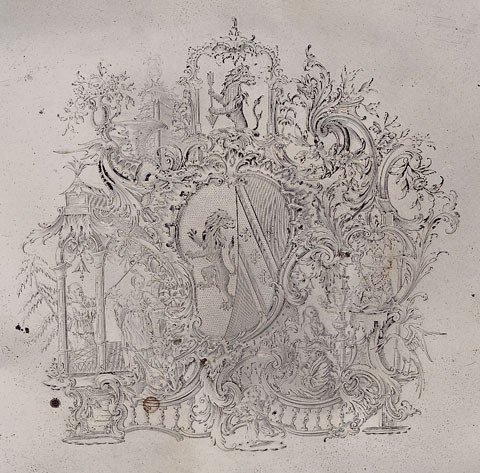
Detail of the engraving on the salver illustrated in fig. 8.
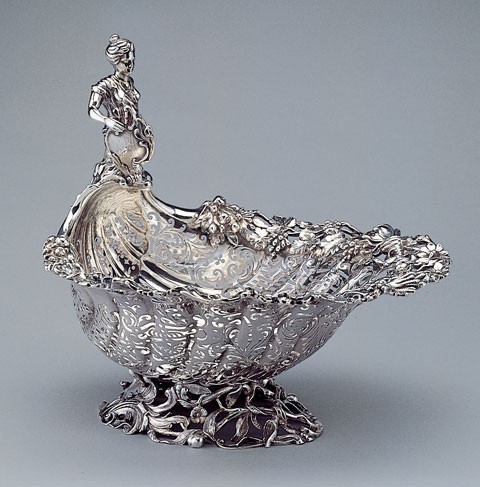
Bread basket by John Wirgman, London, 1754. Silver. H. 12 1/2", L. 13 1/2". (Photo, Gavin Ashworth.)
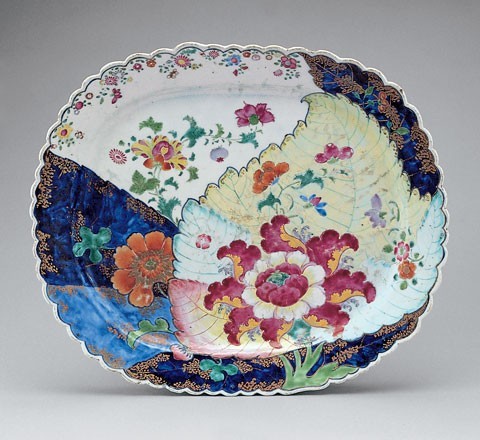
Platter, Chinese export for the British market, 1755–1760. Porcelain. 18" x 15". (Photo, Gavin Ashworth.)
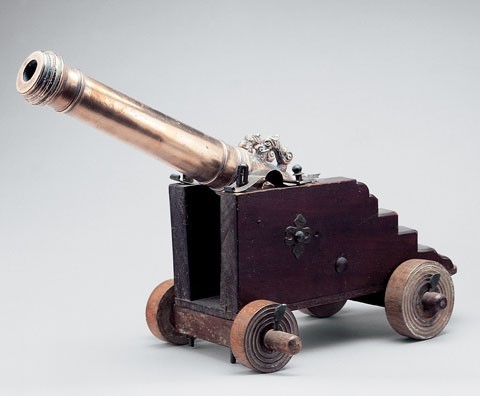
Cannon, England, ca. 1720. Bronze, iron, steel, and wood. L. 26". (Photo, Gavin Ashworth.)
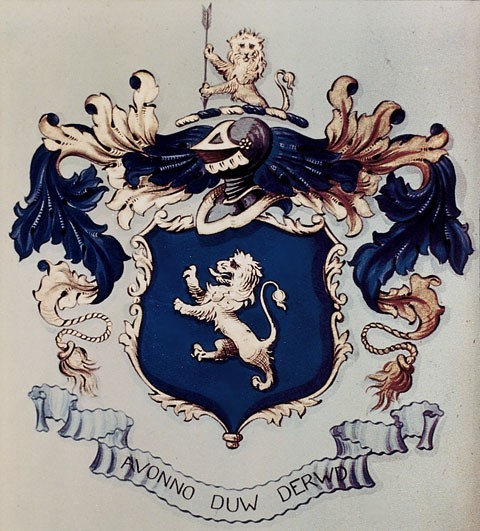
Coat-of-arms of the Lloyd family, England, ca. 1785. Watercolor on paper. 12 3/4" x 15 3/4". (Photo, Gavin Ashworth.)
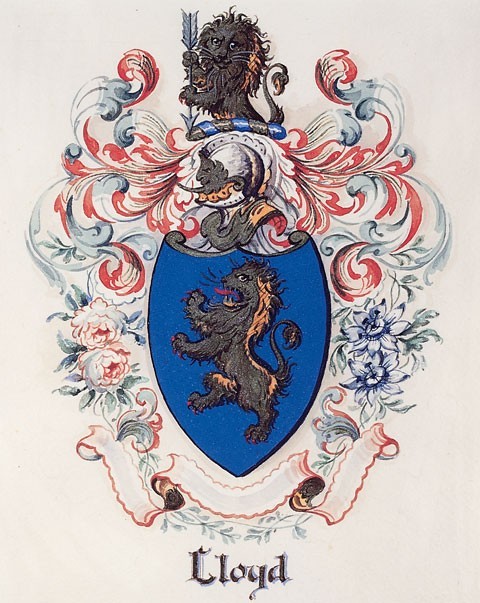
Coat-of-arms of the Lloyd family, England, ca. 1785. Watercolor on paper. 9 3/4" x 7 1/2". (Photo, Gavin Ashworth.)
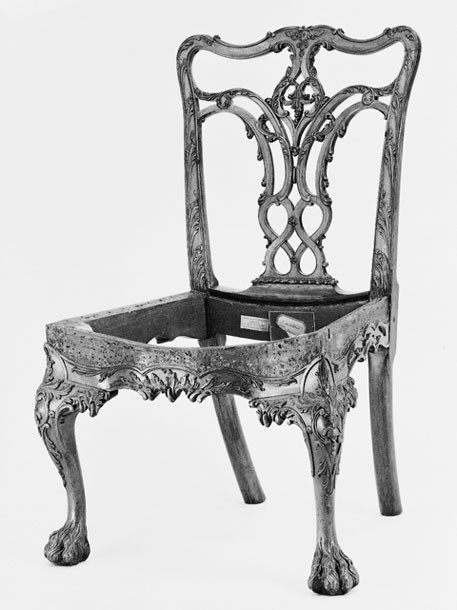
Side chair attributed to the shop of Benjamin Randolph, Philadelphia, Pennsylvania, ca. 1769. Mahogany with white cedar. H. 36 3/4", W. 21 3/4" (seat), D. 17 7/8" (seat). (Chipstone Foundation; photo, Hans Lorenz.)
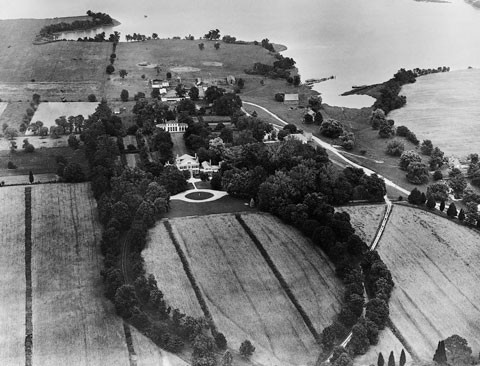
Circa 1935 photograph showing part of the Wye House estate. The house, gardens, and greenhouse are oriented on a north-south axis.
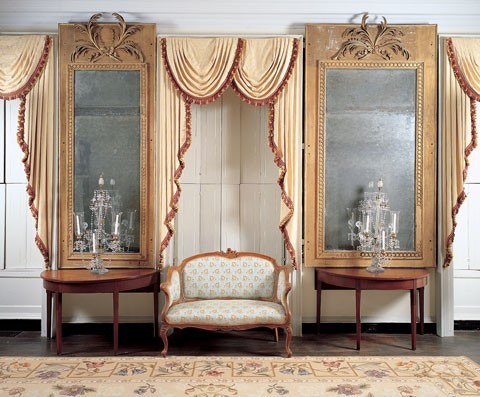
Pier glasses, London, ca. 1755. Woods not identified. Left: H. 104" (not including appliqué), W. 41 1/2". Right: H. 104" (not including appliqué), W. 56 3/4". (Photo, Gavin Ashworth.)
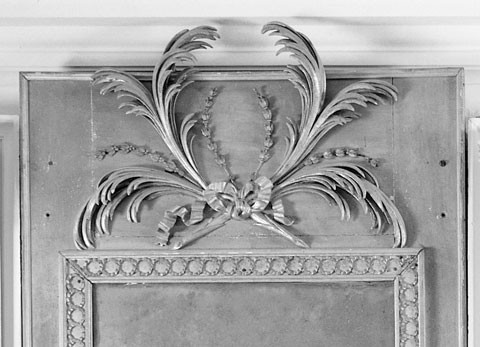
Detail of the appliqué and guilloche on the left pier glass illustrated in fig. 17.
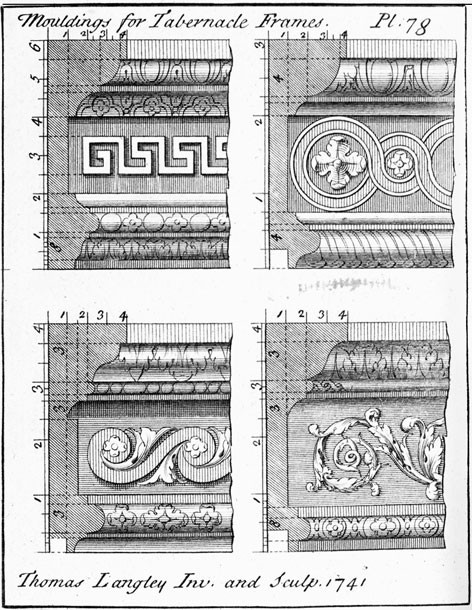
“Moldings for Tabernacle Frames” illustrated on pl. 78 of Batty and Thomas Langley’s The Builder’s Jewell, or Youth’s Instructor (1741). (Courtesy, Winterthur Museum Library: Printed Book and Periodical Collection.)
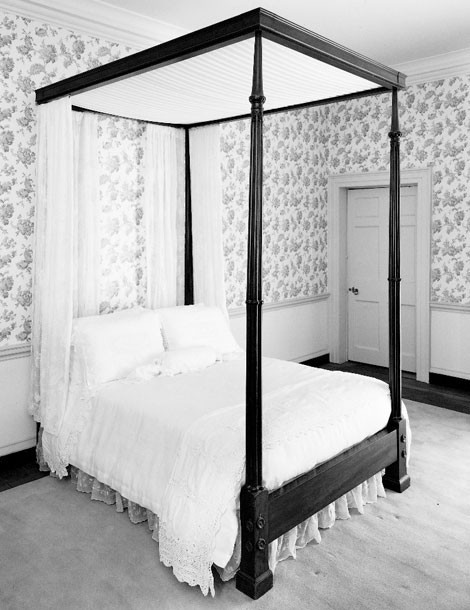
Bedstead with foot posts dating 1755–1770. The mahogany posts are probably British, although similar examples were made in Philadelphia. The bed that the posts came from probably had a carved or molded cornice and elaborate curtains.
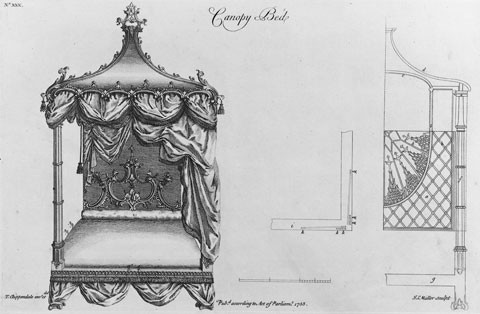
Design for a “Canopy Bed” with gothic posts illustrated on plate 30 in the first edition of Thomas Chippendale’s The Gentleman and Cabinet-Maker’s Director (1754). (Courtesy, Winterthur Library: Printed Book and Periodical Collection.)
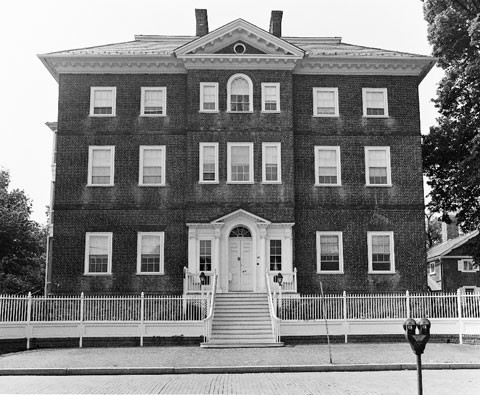
Chase-Lloyd House, Annapolis, Maryland, ca. 1773. Architect William Buckland was responsible for the interior and exterior design. He had previously worked on Mt. Airy, the home of Elizabeth Tayloe’s parents in Richmond County, Virginia.
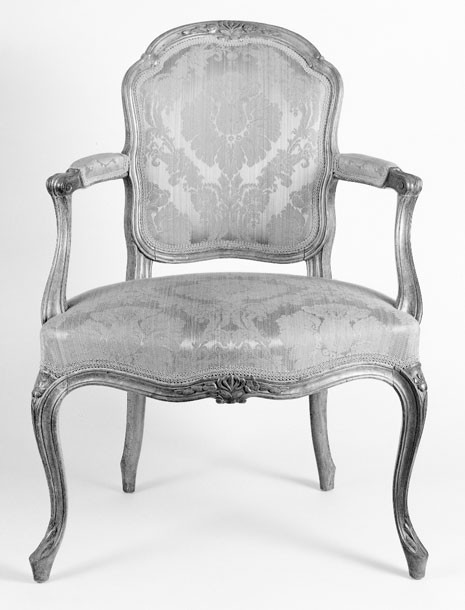
“French chair,” London, ca. 1772. Beech with oak. H. 34 1/2", W. (seat) 24", D. 20" (seat). (Photo, Gavin Ashworth.)
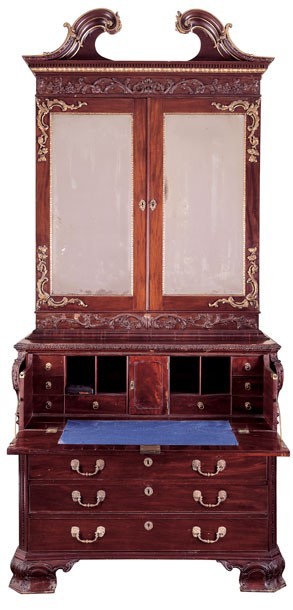
Bureau bookcase, London, 1750– 1760. Mahogany with cedrella, oak, and an unidentified conifer. H. 101", W. 47", D. 24". (Photo, Gavin Ashworth.) The gilding is modern.
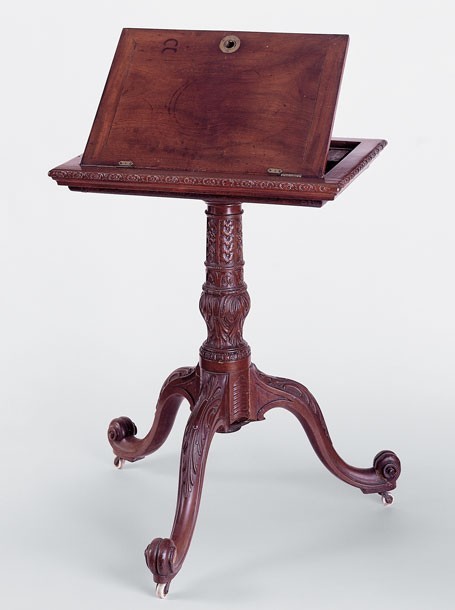
Bookstand, London, 1750–1760. Mahogany. H. 29", W. 24", D. 19". (Photo, Gavin Ashworth.)
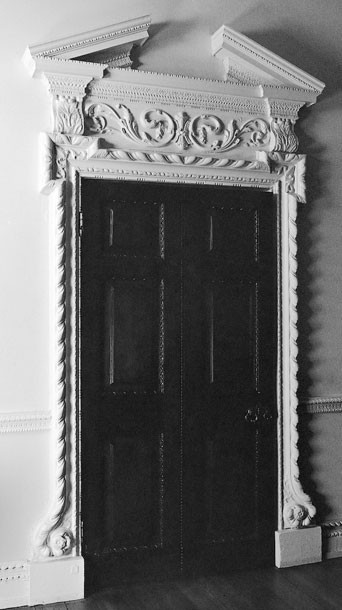
Detail showing one of the doors in the principal first floor room of the Chase-Lloyd House. The carving is attributed to Thomas Hall.
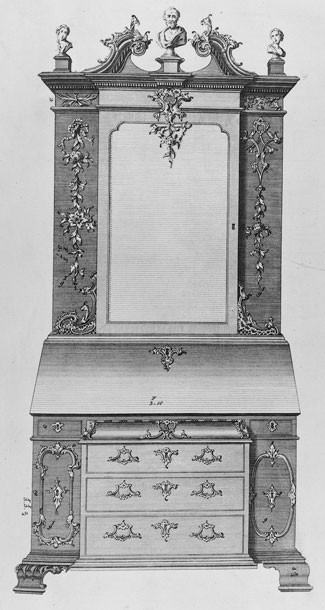
Design for a “Desk and Bookcase” illustrated on plate 78 in the first edition of Thomas Chippendale’s The Gentleman and Cabinet-Maker’s Director (1754). (Courtesy, Winterthur Museum Library: Printed Book and Periodical Collection.) This plate also illustrates leaves bound with ribbon as an optional frieze ornament on the left side. This motif, which occurs on the pier glasses ordered by Edward Lloyd III, was extremely popular in British furniture and architectural carving.
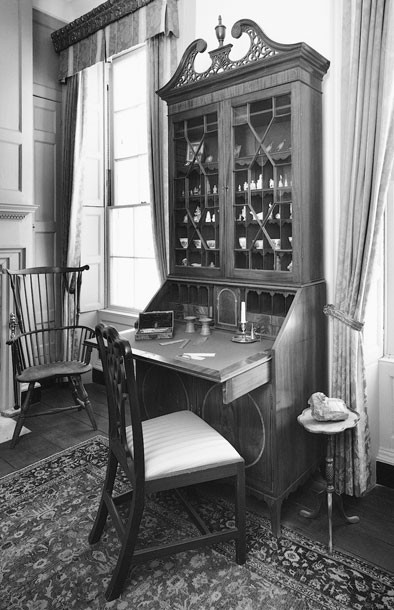
Desk-and-bookcase, Annapolis, John Shaw (active 1771–1819), 1797. Mahogany and light wood inlays with yellow pine and tulip poplar. H. 98 1/2", W. 41 1/4", D. 23 1/2". (Photo, Gavin Ashworth.) The design of the pediment is based on plate 57 of Thomas Sheraton’s The Cabinetmaker and Upholsterer’s Drawing Book (1793).
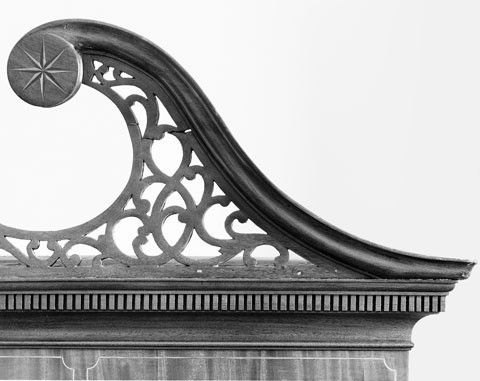
Detail of the pediment of the desk-and-bookcase illustrated in fig. 28. (Photo, Gavin Ashworth.)
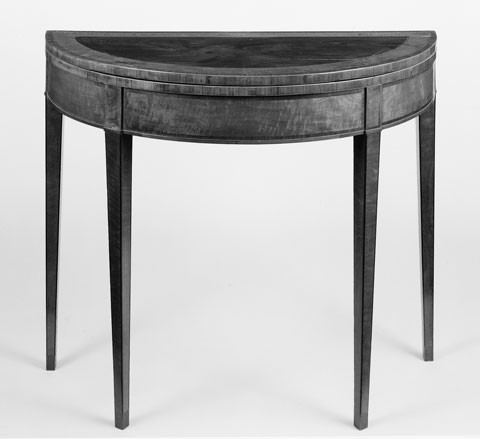
Card table, London, ca. 1772. Mahogany, satinwood and mahogany veneer, ebony and other unidentified inlays with beech and an unidentified soft wood. H. 29 1/2", W. 35 3/4", D. 16 3/4". This table is one of a pair remaining in Wye House. (Photo, Gavin Ashworth.)
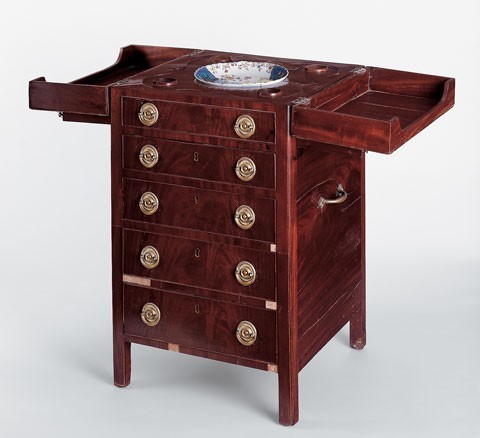
Shaving table, probably Annapolis, Maryland, ca. 1777. Mahogany with tulip poplar and yellow pine. H. 29 1/4", W. 19 3/4", D. 19 3/4". (Photo, Gavin Ashworth.)
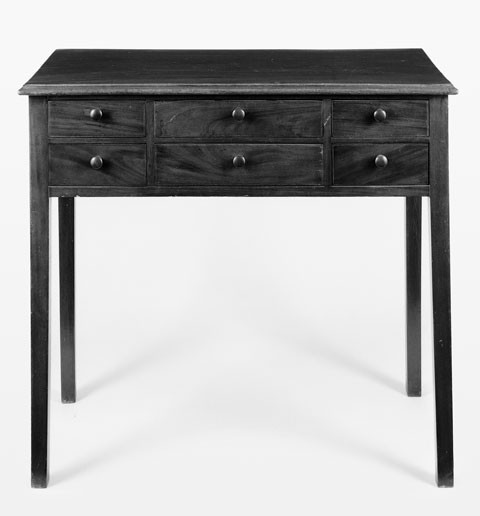
Writing table, probably Annapolis, Maryland, ca. 1773. Mahogany with tulip poplar and yellow pine. H. 33", W. 36", D. 17 1/2". (Photo, Gavin Ashworth.)
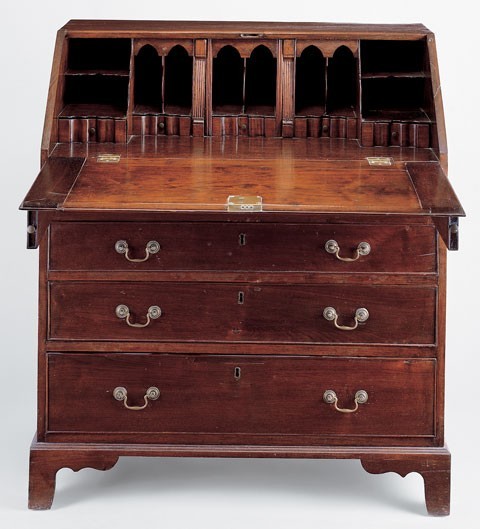
Desk, Eastern Shore or Annapolis vicinity of Maryland, 1765–1780. Walnut with yellow pine. H. 38", W. 35 1/2", D. 18 1/2". (Photo, Gavin Ashworth.)
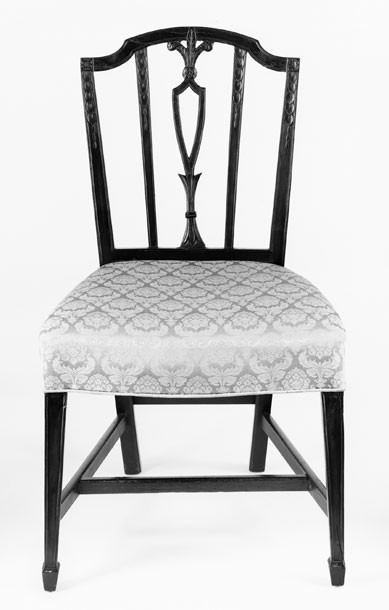
Side chair, England, ca. 1792. Mahogany with beech. H. 35 1/2", W. 21", D. 19". (Photo, Gavin Ashworth.) During the late eighteenth and early nineteenth centuries, Baltimore chair makers produced their own version of this splat design. Imported chairs like those ordered by Edward Lloyd IV probably influenced local production.
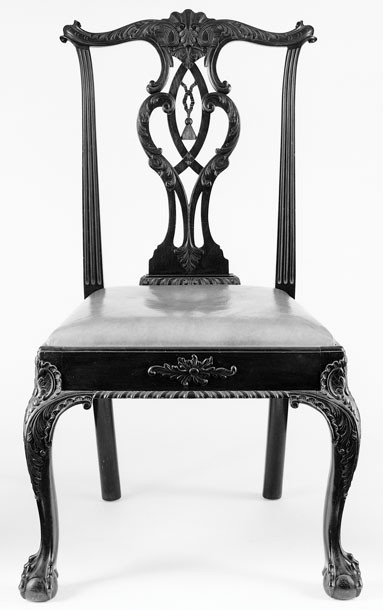
Side chair by Potthast Bros., Baltimore, Maryland, ca. 1917. Mahogany. H. 40", W. 24", D. 19". (Photo, Gavin Ashworth.)
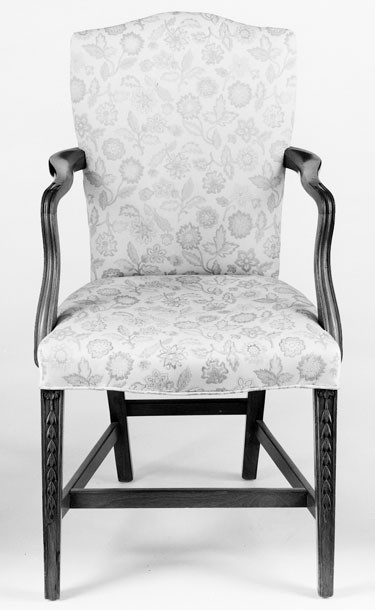
Armchair, England, ca. 1795, modified by J. W. Berry & Sons of Baltimore, Maryland, ca. 1920. Mahogany. H. 37 1/2", W. 22", D. 20". (Photo, Gavin Ashworth.)

Silver and glass plateau by William Pitts and Joseph Preedy with alabaster figures, London, 1792–1793. (Photo, Gavin Ashworth.) The three sections shown here are 52" long. With the two missing sections in place, the plateau measures 89 1/2".
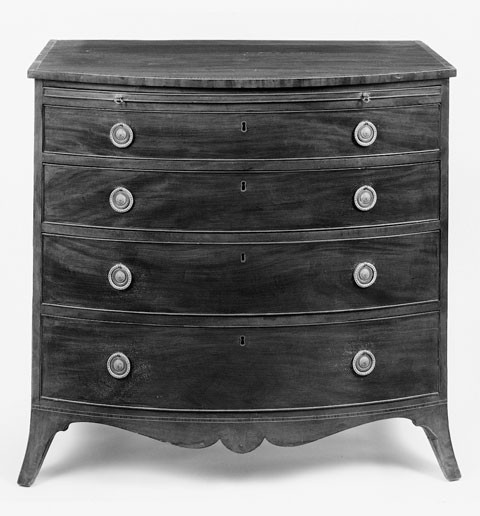
Chest of drawers, England, ca. 1790. Mahogany and light wood inlay with oak and an unidentified soft wood. H. 35", W. 37", D. 22". (Photo, Gavin Ashworth.)
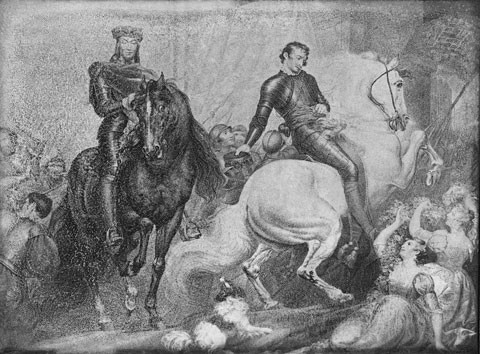
John and Josiah Boydell, Richard III Act V Scene II, London ca. 1792. Etching and engraving on wove paper. Frame dimensions: 22 1/2" x 30 1/2". (Photo, Gavin Ashworth.)
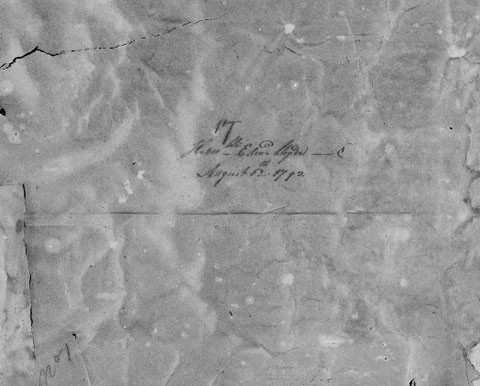
Detail of the back of the print illustrated in fig. 39. The inscription indicates that the print was part of a shipment to Edward Lloyd IV.
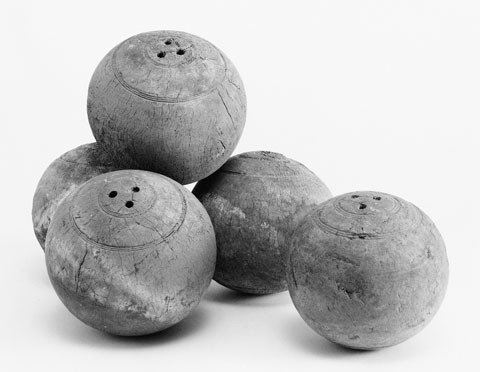
Balls for lawn bowling, England, 1785–1800. (Photo, Gavin Ashworth.)
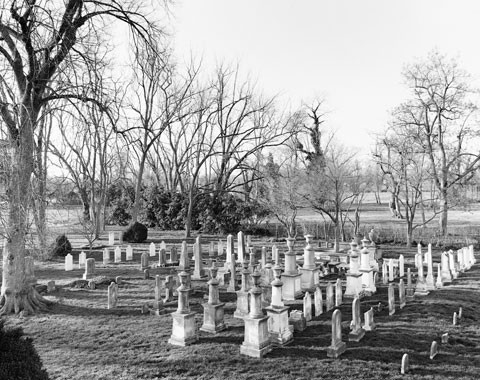
View of the graveyard at Wye. (Photo, Gavin Ashworth.)
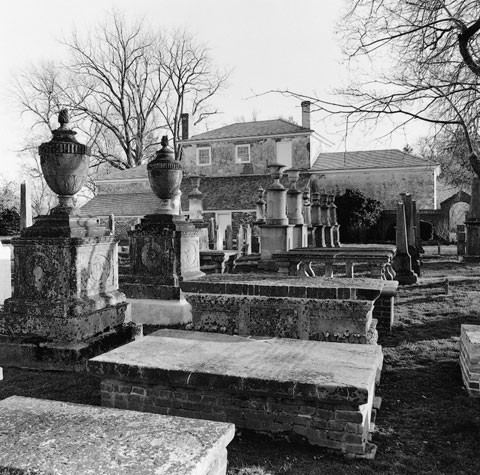
View of the graveyard at Wye. (Photo, Gavin Ashworth.)
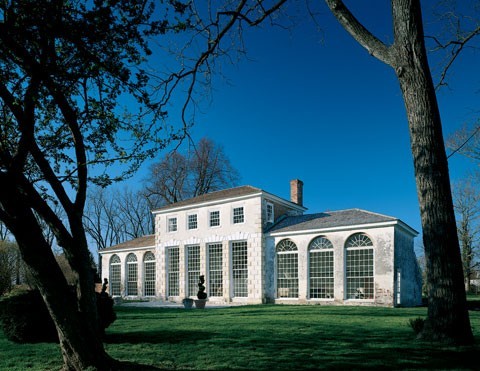
Greenhouse at Wye, Talbot County, Maryland, 1740s and 1786. (Photo, Gavin Ashworth.)
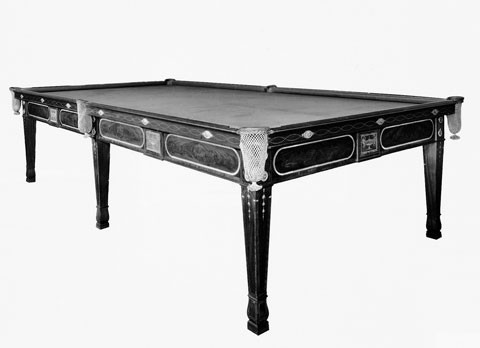
Billiard table by John Shaw, Annapolis, Maryland, ca. 1800. Mahogany and light and dark inlays with tulip poplar and yellow pine. H. 38", L. 139 1/2", W. 72 3/4". (Courtesy, Winterthur Museum.)
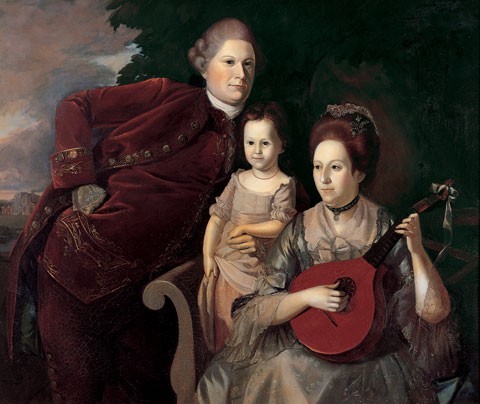
Jonathan Fairbanks after Charles Willson Peale, The Edward Lloyd Family, 1959. Oil on canvas. 43 3/4" x 52". (Photo, Gavin Ashworth.)
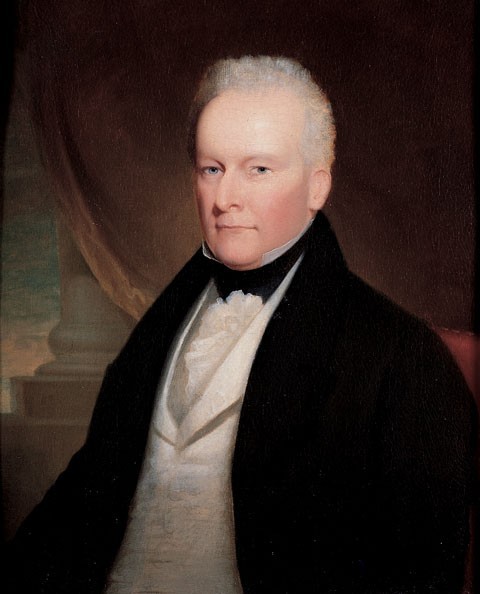
John Beale Bordley (1800–1882), Governor Edward Lloyd V, Maryland, 1828. Oil on canvas. 28 3/4" x 23 3/4". (Photo, Gavin Ashworth.)
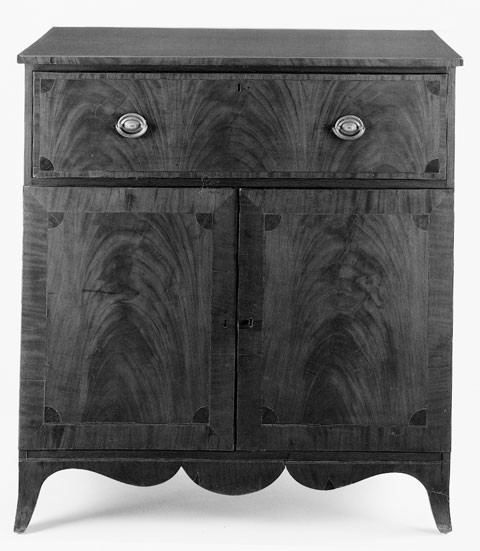
Secretary, Baltimore, Maryland, 1790–1800. Mahogany and light and dark wood inlays with yellow pine, tulip poplar, and white pine. H. 43", W. 42", D. 22". (Photo, Gavin Ashworth.)
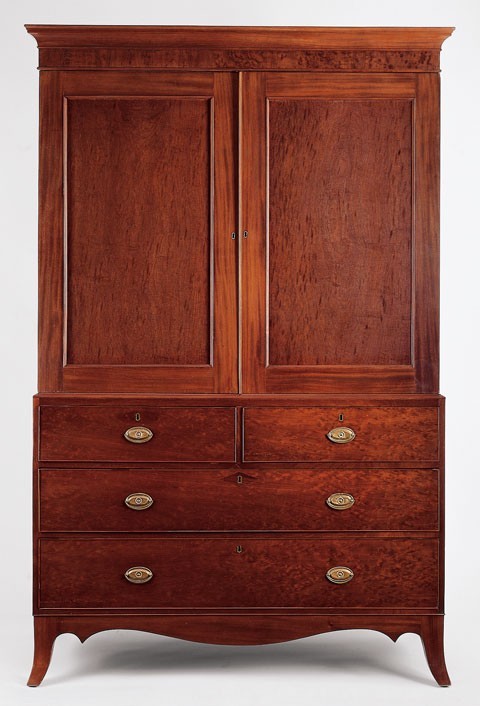
Clothes press, probably by James Martin, Baltimore, Maryland, 1797. Mahogany with tulip poplar and white pine. H. 82 1//2", W. 53 3/4", D. 24". (Photo, Gavin Ashworth.)
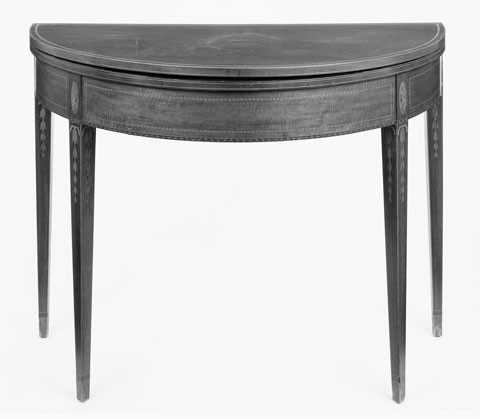
Card table, Baltimore, Maryland, 1790–1800. Mahogany and light and dark wood inlays with white pine, oak, and yellow pine. H. 31 1/2", W. 42 1/2" D. 21" (closed). (Photo, Gavin Ashworth.)
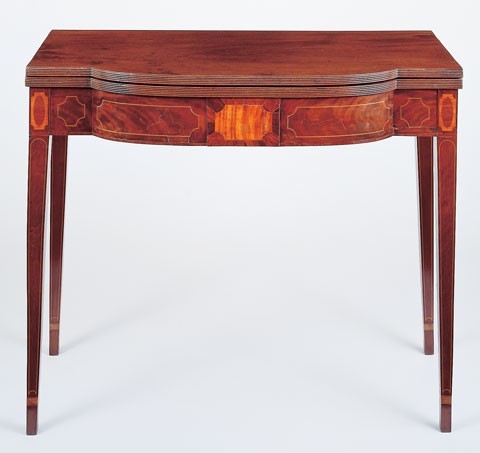
Card table, Baltimore Maryland, 1790–1800. Mahogany and light and dark wood inlays with white pine, oak, and tulip poplar. H. 29 1/2", W. 36", D. 18" (closed). (Photo, Gavin Ashworth.) One of the inlay woods is Botany Bay oak, an exotic from Australia.
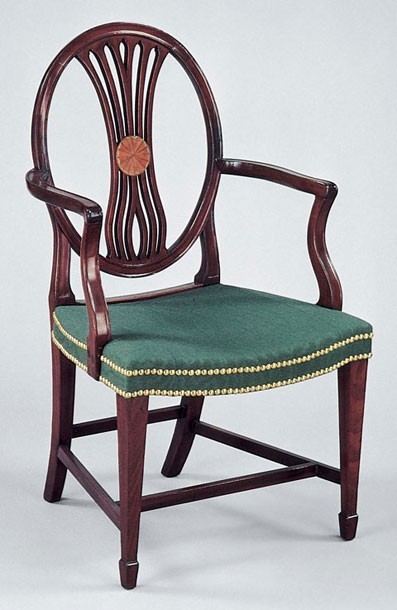
Armchair attributed to William Singleton (active 1790–1803), Baltimore, Maryland, ca. 1800. Mahogany and light wood inlays with tulip poplar, ash, and maple. H. 38", W. 21", D. 19". (Courtesy, Colonial Williamsburg Foundation.)
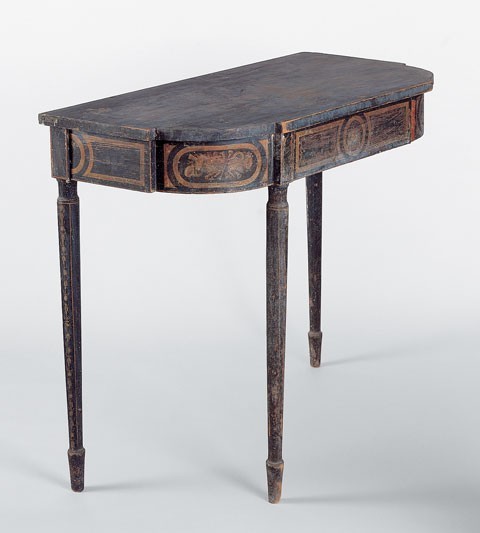
Card table with decoration attributed to John and Hugh Finley, Baltimore, Maryland, 1808–1815. Tulip poplar with oak, white pine, and maple. H. 28 3/4", W. 36", D. 18". (Photo, Gavin Ashworth.)

Cornice by John and Hugh Finley, Baltimore, Maryland, 1828. Tulip poplar. H. 8", L. 59". (Photo, Gavin Ashworth.) The festoon is missing.
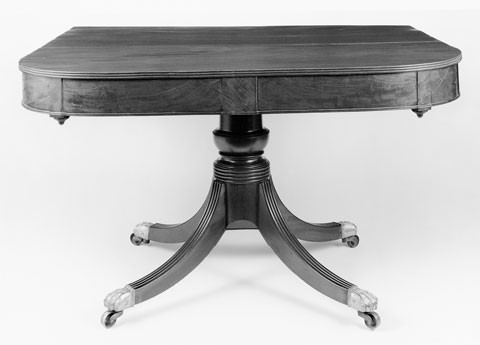
End of a three-part dining table attributed to Edward Priestley (active 1801–1837), Baltimore, Maryland, ca. 1812. Mahogany with tulip poplar and oak. H. 28 1/2", W. 56 3/4", L. 164" (with all sections assembled). (Photo, Gavin Ashworth.)
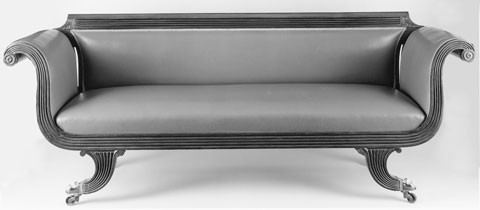
Sofa attributed to Edward Priestley, Baltimore, Maryland, ca. 1812. Mahogany with tulip poplar. H. 35", W. 96", D. 24 1/4". (Photo, Gavin Ashworth.)
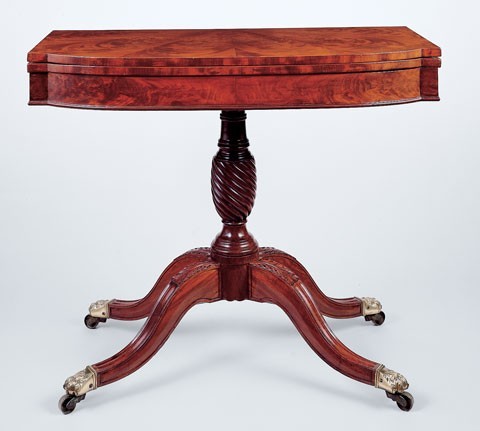
Card table attributed to Edward Priestley, Baltimore, Maryland, ca. 1812. Mahogany with white pine, tulip poplar, oak, and beech. H. 28 3/4", W. 36", D. 17 1/2". (Photo, Gavin Ashworth.)
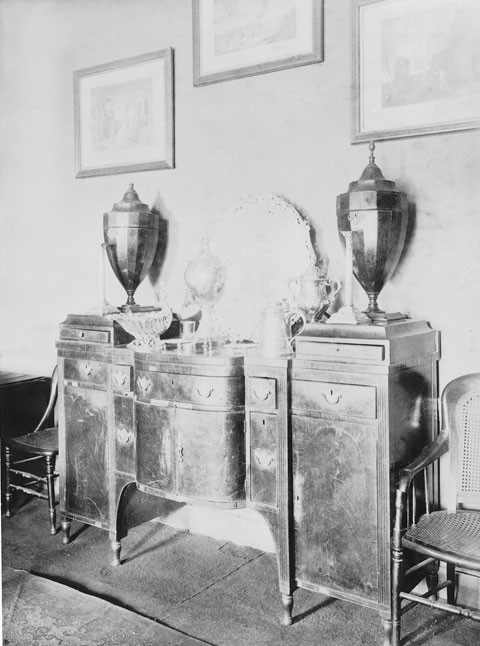
Circa 1915 photograph showing a sideboard attributed to Edward Priestley, Baltimore, Maryland, 1810–1815. (Photo, Gavin Ashworth.)
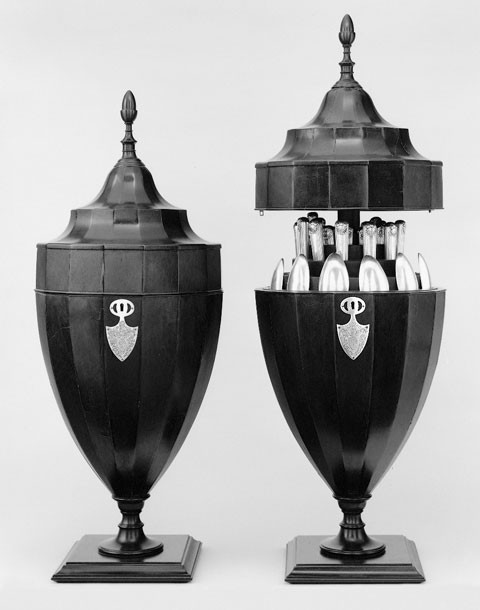
Pair of knife vases, England, ca. 1800. Mahogany with oak and an unidentified conifer. H. 29", Diam. 12 1/2". (Photo, Gavin Ashworth.)
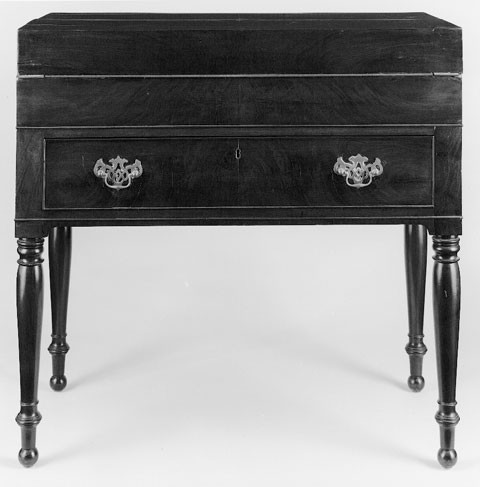
Writing table attributed to Edward Priestley, Baltimore, Maryland, 1810–1815. Mahogany with tulip poplar and white pine; blue baize writing surface. H. 36", W. 36", D. 17 3/4". (Photo, Gavin Ashworth.)
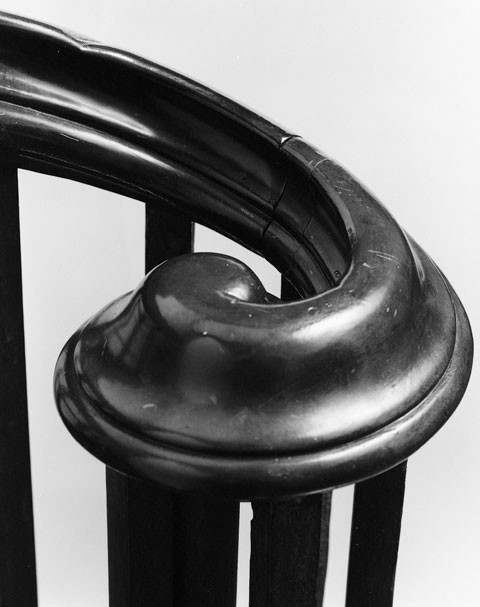
Section of handrailing by Edward Priestley, Baltimore, Maryland, 1826. Mahogany. (Photo, Gavin Ashworth.)
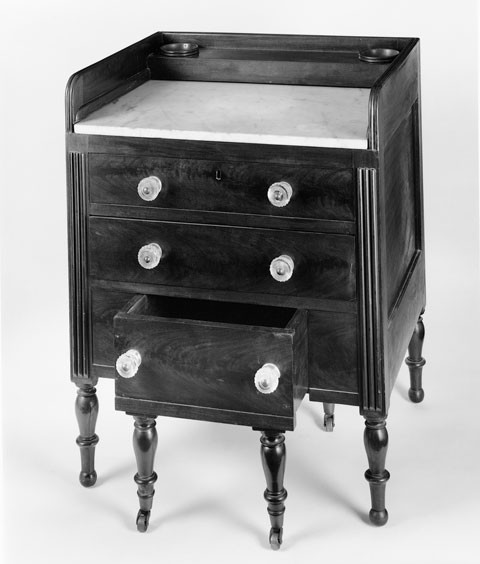
Chamber table, Baltimore, Maryland, ca. 1825. Mahogany with cedrella, white pine, and tulip poplar. H. 33", W. 26", D. 22". (Photo, Gavin Ashworth.)
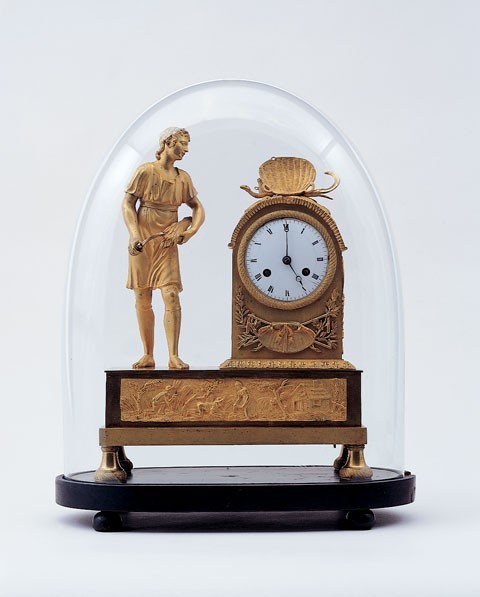
Mantle clock, France, 1810–1820. Bronze, brass, steel, glass, enamel, and silk. H. 14 1/2", W. 11", D. 4 3/4". (Photo, Gavin Ashworth.)
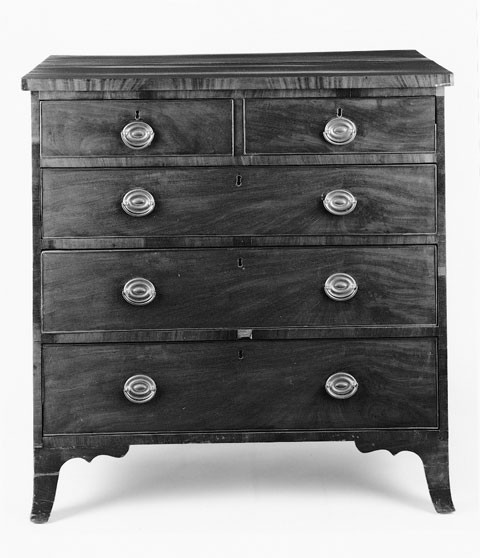
Chest of drawers, Baltimore, Maryland, 1795–1810. Mahogany with tulip poplar and white pine. H. 39 1/4", W. 39 1/2", D. 21 1/4". (Photo, Gavin Ashworth.) This chest is one of four that remain in Wye House.
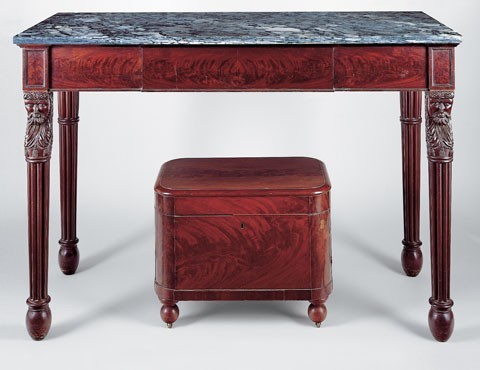
Sideboard table and liquor case by Edward Priestley, Baltimore, Maryland, 1827. Sideboard table: Mahogany with tulip poplar and white pine; Pennsylvania clouded limestone. H. 42 3/4", W. 62", D. 26 3/4". Liquor case: Mahogany with tulip poplar and white pine. H. 20 1/4", W. 26 1/2", D. 17 1/2". (Photo, Gavin Ashworth.) Carved heads like those on the table are illustrated on plate 57 of Thomas Hope’s Household Furniture and Interior Decoration (1807).
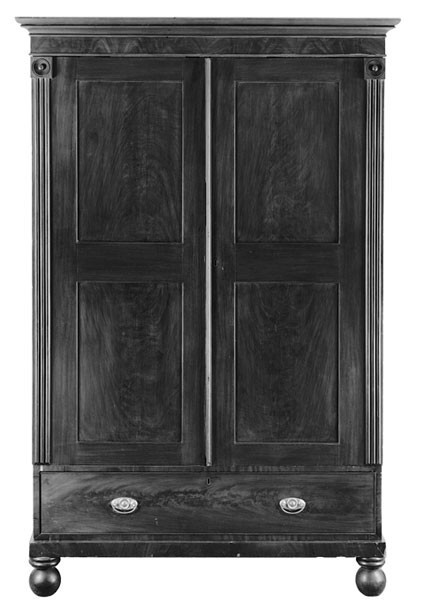
Wardrobe, Baltimore, Maryland, 1825–1835. Mahogany with white pine and tulip poplar. H. 82", W. 54", D. 23 1/2". (Photo, Gavin Ashworth.)
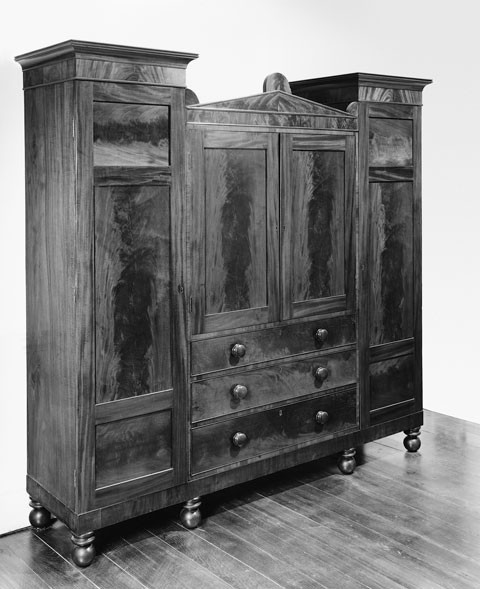
Wardrobe, Baltimore, Maryland, ca. 1825. Mahogany with white pine and tulip poplar. H. 80", W. 80", D. 20". (Photo, Gavin Ashworth.)
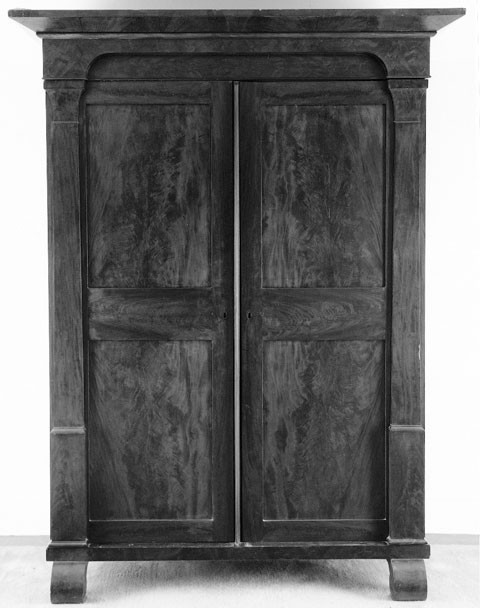
Wardrobe, Baltimore, Maryland, 1835–1845. Mahogany and rosewood inlay with white pine and tulip poplar. H. 86 3/4", W. 57", D. 21 1/2". (Photo, Gavin Ashworth.)
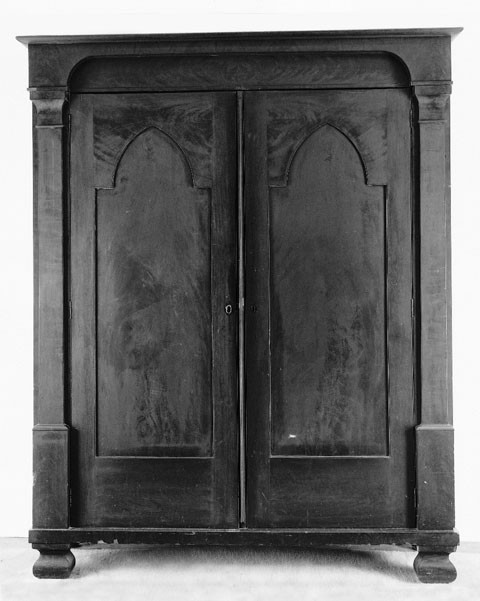
Wardrobe, Baltimore, Maryland, 1835–1845. Mahogany with white pine, tulip poplar, and white cedar. H. 84 1/2", W. 66 1/4", D. 21". (Photo, Gavin Ashworth.)
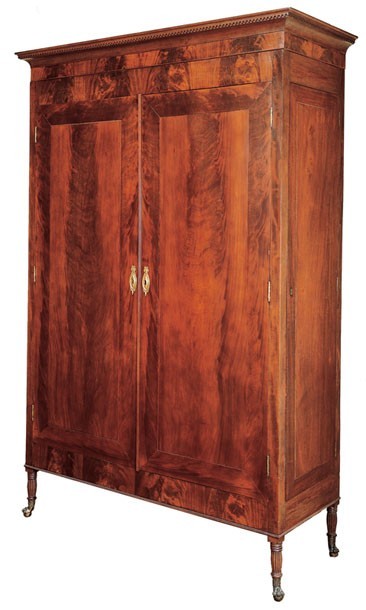
Armoire, probably New Orleans, Louisiana, ca. 1825. Mahogany with cypress, tulip poplar, and white pine. H. 90 1/2", W. 56 1/2", D. 21 3/4". (Photo, Gavin Ashworth.)
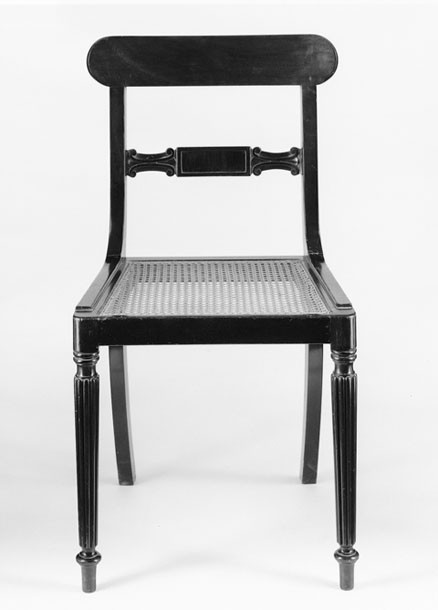
Side chair, possibly by Tweed & Bonnell, New York, 1835–1840. Mahogany. H. 34", W. 18 1/2", D. 18 1/2". (Photo, Gavin Ashworth.)
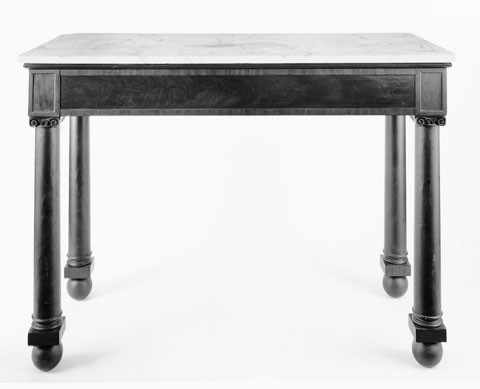
Sideboard table, Baltimore, Maryland, 1825–1835. Mahogany with tulip poplar, oak, and white pine; marble. H. 40", W. 56", D. 24 3/4". (Photo, Gavin Ashworth.)
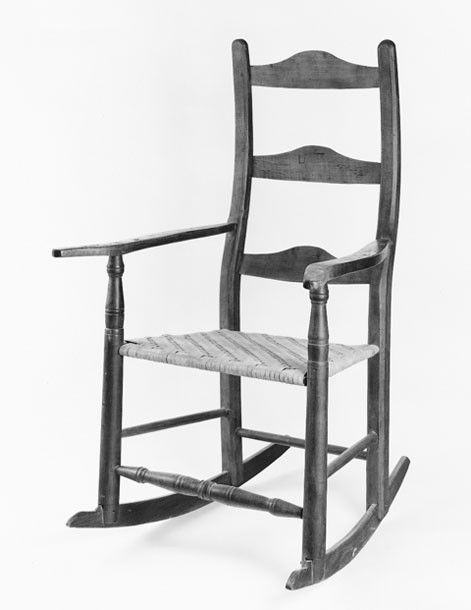
Rocking chair, probably Talbot County, Maryland, 1830–1840. Maple with oak. H. 46", W. 28 1/2", D. 33". (Photo, Gavin Ashworth.)
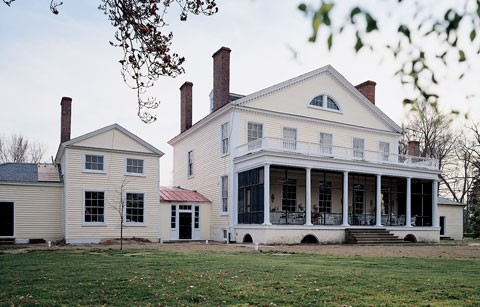
View of the north side of Wye House. (Photo, Gavin Ashworth.)
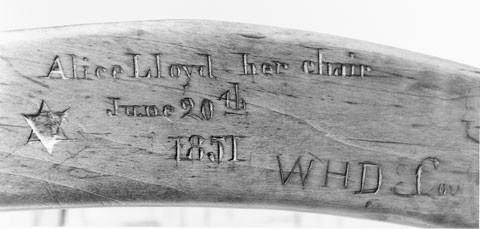
Detail of the left arm of the rocking chair illustrated in fig. 73.
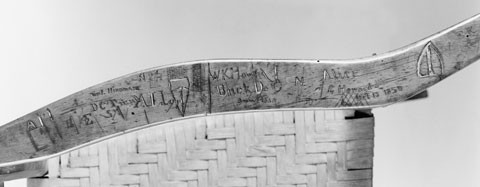
Detail of the right arm of the rocking chair illustrated in fig. 73.
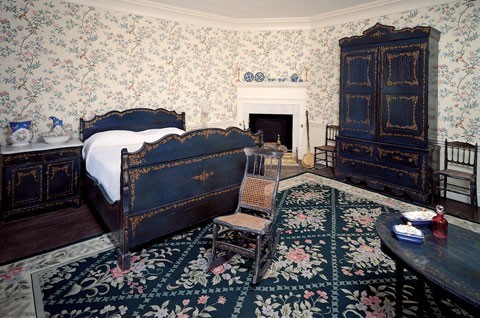
Bedroom suite, Hart, Ware & Co., probably Baltimore, ca. 1855. (Photo, Gavin Ashworth.) Hart, Ware & Co. maintained warehouses in Philadelphia from 1852 to 1854 and in Baltimore from 1855 to 1859. The suite has painted decoration in imitation of mother-of-pearl.
